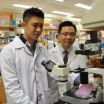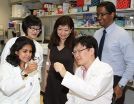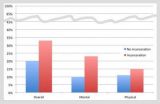(Press-News.org) RICHLAND, Wash. – Sun, wind and other renewable energy sources could make up a larger portion of the electricity America consumes if better batteries could be built to store the intermittent energy for cloudy, windless days. Now a new material could allow more utilities to store large amounts of renewable energy and make the nation's power system more reliable and resilient.
A paper published today in Nature Communications describes an electrode made of a liquid metal alloy that enables sodium-beta batteries to operate at significantly lower temperatures. The new electrode enables sodium-beta batteries to last longer, helps streamline their manufacturing process and reduces the risk of accidental fire.
"Running at lower temperatures can make a big difference for sodium-beta batteries and may enable batteries to store more renewable energy and strengthen the power grid," said material scientist Xiaochuan Lu of the Department of Energy's Pacific Northwest National Laboratory.
Need for energy storage, but challenges remain
More than 300 megawatts of large, cargo container-sized sodium-beta batteries are running in the United States, Japan and Europe, according to Dupont Energy Consulting. They often store electricity generated by rows of solar panels and wind turbines.
But their broader use has been limited because of their high operating temperature, which reaches up to 350 degrees Celsius, or more than three times the boiling point of water. Such high operating temperatures requires sodium-beta batteries to use more expensive materials and shortens their operating lifespans. PNNL researchers set out to reduce the battery's operating temperature, knowing that could make the battery more efficient and last longer.
The traditional design of sodium-beta batteries consists of two electrodes separated by a solid membrane made of the ceramic material beta alumina. There are two main types of sodium-beta batteries, based on the materials used for the positive electrode: those that use sulfur are called sodium-sulfur batteries, while those that use nickel chloride are known as ZEBRA batteries. Electricity is generated when electrons flow between the battery's electrodes.
Lowering the battery's operating temperature creates several other technical challenges. Key among them is getting the negative sodium electrode to fully coat, or "wet" the ceramic electrolyte. Molten sodium resists covering beta alumina's surface when it's below 400 degrees Celsius, causing sodium to curl up like a drop of oil in water, making the battery less efficient. For decades researchers have tried to overcome this by applying different coatings to the membrane.
New electrode offers different take
Lu and his PNNL colleagues took an entirely different approach to the wettability problem: modifying the negative electrode. Instead of using pure sodium, they experimented with sodium alloys, or sodium blended with other metals. The team determined a liquid sodium-cesium alloy spreads out well on the beta alumina membrane.
PNNL's new electrode material enables the battery to operate at lower temperatures. Instead of the 350 degrees Celsius at which traditional sodium-beta batteries operate, a test battery with the new electrode worked well at 150 degrees – with a power capacity of 420 milliampere-hours per gram, matching the capacity of the traditional design.
Batteries with the new alloy electrode also retain more of their original energy storage capacity. After 100 charge and discharge cycles, a test battery with PNNL's electrode maintained about 97 percent of its initial storage capacity, while a battery with the traditional, sodium-only electrode maintained 70 percent after 60 cycles.
A battery with a lower operating temperature can also use less expensive materials such as polymers -- which would melt at 350 degrees Celsius -- for its external casing instead of steel. Using less expensive and sensitive materials would also help streamline the battery's manufacturing process. This offsets some of the increased cost associated with using cesium, which is more expensive than sodium.
The PNNL research team is now building a larger electrode to test with a larger battery to bring the technology closer to the scale needed to store renewable energy.
INFORMATION:
This research was supported by DOE's Office of Electricity Delivery and Energy Reliability and internal PNNL funding.
REFERENCE: Xiaochuan Lu, Guosheng Li, Jin Y. Kim, Donghai Mei, John P. Lemmon, Vincent L. Sprenkle, Jun Liu, "Liquid Metal Electrode to Enable Ultra-Low Temperature Sodium0Beta Alumina Batteries for Renewable Energy Storage," Nature Communications, DOI: 10.1038/ncomms5578, Aug. 1, 2014.
Interdisciplinary teams at Pacific Northwest National Laboratory address many of America's most pressing issues in energy, the environment and national security through advances in basic and applied science. Founded in 1965, PNNL employs 4,300 staff and has an annual budget of about $950 million. It is managed by Battelle for the U.S. Department of Energy's Office of Science. As the single largest supporter of basic research in the physical sciences in the United States, the Office of Science is working to address some of the most pressing challenges of our time. For more information on PNNL, visit the PNNL News Center, or follow PNNL on Facebook, Google+, LinkedIn and Twitter.
'Wetting' a battery's appetite for renewable energy storage
New liquid alloy electrode improves sodium-beta battery performance
2014-08-01
ELSE PRESS RELEASES FROM THIS DATE:
NUS study shows effectiveness of common anti-malarial drug in controlling asthma
2014-08-01
Asthmatic patients may soon have a more effective way to control the condition, thanks to a new pharmacological discovery by researchers from the National University of Singapore (NUS).
The team, led by Associate Professor Fred Wong from the Department of Pharmacology at the NUS Yong Loo Lin School of Medicine, together with Dr Eugene Ho Wanxing, a recent PhD graduate from the Saw Swee Hock School of Public Health at NUS, discovered that artesunate, a common herbal-based anti-malarial drug, can be used to control asthma, with better treatment outcomes than other drugs ...
Preterm children do not have an increased risk for dyscalculia
2014-08-01
Preterm children do not suffer from dyscalculia more often than healthy full term children. Dr Julia Jäkel, a developmental psychologist from Bochum, and her colleague Prof Dr Dieter Wolke from the University of Warwick, UK proved this thesis to be true in their analyses – thus refuting previous scientific studies. Unlike other studies, the researchers took the children's IQ into consideration.
Dyscalculia in preterm children often impossible to diagnose
Preterm children often have cognitive deficits; they find solving complex tasks particularly difficult. However, ...
Scientists solve 2000-year-old mystery of the binding media in China's polychrome Terracotta Army
2014-08-01
Even as he conquered rival kingdoms to create the first united Chinese empire in 221 B.C., China's First Emperor Qin Shihuang ordered the building of a glorious underground palace complex, mirroring his imperial capital near present-day Xi'an, that would last for an eternity.
To protect his underworld palaces, the First Emperor issued instructions that his imperial guard be replicated, down to the finest details, in red-brown terracotta clay, poised to do battle. Thousands of these imperial guards were initially discovered in 1974; some contained patches of pigment that ...
Taking the guesswork out of cancer therapy
2014-08-01
Researchers and doctors at the Institute of Bioengineering and Nanotechnology (IBN), Singapore General Hospital (SGH) and National Cancer Centre Singapore (NCCS) have co-developed the first molecular test kit that can predict treatment and survival outcomes in kidney cancer patients. This breakthrough was recently reported in European Urology, the world's top urology journal.
According to IBN Executive Director Professor Jackie Y. Ying, "By combining our expertise in molecular diagnostics and cancer research, we have developed the first genetic test to help doctors prescribe ...
Georgia Tech jailbreaks iOS 7.1.2
2014-08-01
Security researchers at the Georgia Tech Information Security Center (GTISC) have discovered a way to jailbreak current generation Apple iOS devices (e.g., iPhones and iPads) running the latest iOS software.
The jailbreak, which enables circumvention of Apple's closed platform, was discovered by analyzing previously patched vulnerabilities with incomplete fixes.
It shows that quick workarounds mitigating only a subset of a multi-step attack leave these devices vulnerable to exploitation. Patching all vulnerabilities for a modern, complex software system (i.e., Windows ...
Symbiotic survival
2014-08-01
Boulder, Colo., USA – One of the most diverse families in the ocean today -- marine bivalve mollusks known as Lucinidae (or lucinids) -- originated more than 400 million years ago in the Silurian period, with adaptations and life habits like those of its modern members. This Geology study by Steven Stanley of the University of Hawaii, published online on 25 July 2014, tracks the remarkable evolutionary expansion of the lucinids through significant symbiotic relationships.
At is origin, the Lucinidae family remained at very low diversity until the rise of mangroves and ...
Companion planets can increase old worlds' chance at life
2014-08-01
Having a companion in old age is good for people — and, it turns out, might extend the chance for life on certain Earth-sized planets in the cosmos as well.
Planets cool as they age. Over time their molten cores solidify and inner heat-generating activity dwindles, becoming less able to keep the world habitable by regulating carbon dioxide to prevent runaway heating or cooling.
But astronomers at the University of Washington and the University of Arizona have found that for certain planets about the size of our own, the gravitational pull of an outer companion planet ...
Jailed family member increases risks for kids' adult health
2014-08-01
PROVIDENCE, R.I. [Brown University] — New research shows that people who grew up in a household where a member was incarcerated have a 16-percent greater risk of experiencing poor health quality than adults who did not have a family member sent to prison. The finding, which accounted for other forms of childhood adversity, suggests that the nation's high rate of imprisonment may be independently imparting enduring physical and mental health difficulties in some families.
"These people were children when this happened, and it was a significant disruptive event," said Annie ...
2014 ESC/ESA Guidelines on non-cardiac surgery: Cardiovascular assessment and management
2014-08-01
The publication of the new joint ESC/ESA Guidelines on non-cardiac surgery: cardiovascular assessment and management introduces a number of recommendations in the field. Among other topics, the Guidelines include updated information on the use of clinical indices and biomarkers in risk assessment, and the use of novel anticoagulants, statins, aspirin and beta-blockers in risk mitigation.
Worldwide, non-cardiac surgery is associated with an average overall complication rate of between 7% and 11% and a mortality rate between 0.8% and 1.5%, depending on safety precautions. ...
Chemists develop MRI technique for peeking inside battery-like devices
2014-08-01
A team of chemists from New York University and the University of Cambridge has developed a method for examining the inner workings of battery-like devices called supercapacitors, which can be charged up extremely quickly and can deliver high electrical power. Their technique, based on magnetic resonance imaging (MRI), establishes a means for monitoring and potentially enhancing the performance of such devices.
The work, which appears in the latest issue of the journal Nature Communications, focuses on electric double-layer capacitors (EDLCs), a type of so-called supercapacitor. ...
LAST 30 PRESS RELEASES:
Bluey’s dad offered professorial chair in archaeology at Griffith University
Beyond small data limitations: Transfer learning-enabled framework for predicting mechanical properties of aluminum matrix composites
Unveiling non-thermal catalytic origin of direct current-promoted catalysis for energy-efficient transformation of greenhouse gases to valuable chemicals
Chronic breathlessness emerging as a hidden strain on hospitals
Paleontologists find first fossil bee nests made inside fossil bones
These fossils were the perfect home for ancient baby bees
Not everyone reads the room the same. A new study examines why.
New research identifies linked energy, immune and vascular changes in ME/CFS
Concurrent frailty + depression likely boost dementia risk in older people
Living in substandard housing linked to kids’ missed schooling and poor grades
Little awareness of medical + psychological complexities of steroid cream withdrawal
Eight in 10 trusts caring for emergency department patients in corridors, finds BMJ investigation
NASA’s Webb telescope finds bizarre atmosphere on a lemon-shaped exoplanet
The gut bacteria that put the brakes on weight gain in mice
Exploring how patients feel about AI transcription
Category ‘6’ tropical cyclone hot spots are growing
Video: Drivers struggle to multitask when using dashboard touch screens, study finds
SLU research shows surge in alcohol-related liver disease driving ‘deaths of despair’
Rising heat reshapes how microbes break down microplastics, new review finds
Roots reveal a hidden carbon pathway in maize plants
Membrane magic: FAMU-FSU researchers repurpose fuel cells membranes for new applications
UN Member States pledge to increase access to diagnosis and inhaled medicines for the 480 million people living with COPD
Combination therapy shows potential to treat pediatric brain cancer ATRT
Study links seabird nesting to shark turf wars in Hawai‘i
Legal sports betting linked to sharp increases in violent crime, study finds
Breakthrough AI from NYUAD speeds up discovery of life-supporting microbes
New Eva Mayr-Stihl Foundation funding initiative boosts research at University of Freiburg on adaptation of forests to global change
The perfect plastic? Plant-based, fully saltwater degradable, zero microplastics
Bias in data may be blocking AI’s potential to combat antibiotic resistance
Article-level metrics would provide more recognition to most researchers than journal-level metrics
[Press-News.org] 'Wetting' a battery's appetite for renewable energy storageNew liquid alloy electrode improves sodium-beta battery performance




